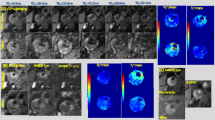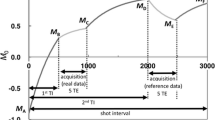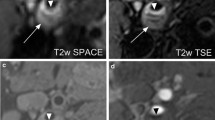Abstract
Introduction
Ultrasmall superparamagnetic iron oxide (USPIO)-enhanced MRI has been shown to be a useful modality to image activated macrophages in vivo, which are principally responsible for plaque inflammation. This study determined the optimum imaging time-window to detect maximal signal change post-USPIO infusion using T1-weighted (T1w), T2*-weighted (T2*w) and quantitative T2* (qT2*) imaging.
Methods
Six patients with an asymptomatic carotid stenosis underwent high resolution T1w, T2*w and qT2* MR imaging of their carotid arteries at 1.5 T. Imaging was performed before and at 24, 36, 48, 72 and 96 h after USPIO (Sinerem™, Guerbet, France) infusion. Each slice showing atherosclerotic plaque was manually segmented into quadrants and signal changes in each quadrant were fitted to an exponential power function to model the optimum time for post-infusion imaging.
Results
The power function determining the mean time to convergence for all patients was 46, 41 and 39 h for the T1w, T2*w and qT2* sequences, respectively. When modelling each patient individually, 90% of the maximum signal intensity change was observed at 36 h for three, four and six patients on T1w, T2*w and qT2*, respectively. The rates of signal change decrease after this period but signal change was still evident up to 96 h.
Conclusion
This study showed that a suitable imaging window for T1w, T2*w and qT2* signal changes post-USPIO infusion was between 36 and 48 h. Logistically, this would be convenient in bringing patients back for one post-contrast MRI, but validation is required in a larger cohort of patients.





Similar content being viewed by others
References
Herborn CU, Vogt FM, Lauenstein TC, Dirsch O, Corot C, Robert P, Ruehm SG (2006) Magnetic resonance imaging of experimental atherosclerotic plaque: comparison of two ultrasmall superparamagnetic particles of iron oxide. J Magn Reson Imaging 24:388–393. doi:10.1002/jmri.20649
Hyafil F, Laissy JP, Mazighi M, Tchetche D, Louedec L, Adle-Biassette H, Chillon S, Henin D, Jacob MP, Letourneur D, Feldman LJ (2006) Ferumoxtran-10-enhanced MRI of the hypercholesterolemic rabbit aorta: relationship between signal loss and macrophage infiltration. Arterioscler Thromb Vasc Biol 26:176–181. doi:10.1161/01.ATV.0000194098.82677.57
Ruehm SG, Corot C, Vogt P, Kolb S, Debatin JF (2001) Magnetic resonance imaging of atherosclerotic plaque with ultrasmall superparamagnetic particles of iron oxide in hyperlipidemic rabbits. Circulation 103:415–422
Yancy AD, Olzinski AR, Hu TC, Lenhard SC, Aravindhan K, Gruver SM, Jacobs PM, Willette RN, Jucker BM (2005) Differential uptake of ferumoxtran-10 and ferumoxytol, ultrasmall superparamagnetic iron oxide contrast agents in rabbit: critical determinants of atherosclerotic plaque labeling. J Magn Reson Imaging 21:432–442. doi:10.1002/jmri.20283
Kooi ME, Cappendijk VC, Cleutjens KB, Kessels AG, Kitslaar PJ, Borgers M, Frederik PM, Daemen MJ, van Engelshoven JM (2003) Accumulation of ultrasmall superparamagnetic particles of iron oxide in human atherosclerotic plaques can be detected by in vivo magnetic resonance imaging. Circulation 107:2453–2458. doi:10.1161/01.CIR.0000068315.98705.CC
Trivedi RA, Mallawarachi C, U-King-Im JM, Graves MJ, Horsley J, Goddard MJ, Brown A, Wang L, Kirkpatrick PJ, Brown J, Gillard JH (2006) Identifying inflamed carotid plaques using in vivo USPIO-Enhanced MR imaging to label plaque macrophages. Arterioscler Thromb Vasc Biol 26:1601–1606. doi:10.1161/01.ATV.0000222920.59760.df
Tang T, Howarth SP, Miller SR, Trivedi R, Graves MJ, U-kIng-Im JM, Li ZY, Brown AP, Kirkpatrick PJ, Gaunt ME, Gillard JH (2006) Assessment of inflammatory burden contralateral to the symptomatic carotid stenosis using high-resolution ultrasmall, superparamagnetic iron oxide-enhanced MRI. Stroke 37:2266–2270. doi:10.1161/01.STR.0000236063.47539.99
Trivedi RA, U-King-Im JM, Graves MJ, Kirkpatrick PJ, Gillard JH (2004) Noninvasive imaging of carotid plaque inflammation. Neurology 63:187–188
Trivedi RA, UK-I JM, Graves MJ, Cross JJ, Horsley J, Goddard MJ, Skepper JN, Quartey G, Warburton E, Joubert I, Wang L, Kirkpatrick PJ, Brown J, Gillard JH (2004) In vivo detection of macrophages in human carotid atheroma: temporal dependence of ultrasmall superparamagnetic particles of iron oxide-enhanced MRI. Stroke 35:1631–1635. doi:10.1161/01.STR.0000131268.50418.b7
Trivedi RA, UK-I JM, Graves MJ, Kirkpatrick PJ, Gillard JH (2004) Noninvasive imaging of carotid plaque inflammation. Neurology 63:187–188
Howarth SPS, Tang TY, Li ZY, Miller SR, Weerakkody RA, Graves MJ U- King-Im, J. M., Walsh, S. R., Boyle, J. R., Gaunt, M. E., Kirkpatrick, P. J., Gillard, J. H. (2009) Utility of USPIO-enhanced MR imaging to identify inflammation and the fibrous cap: a comparison of symptomatic and asymptomatic individuals. Eur J Radiol (in press).
Tang TY (2007) A 12-week, randomised, double-blind study evaluating the effects of low-dose (10 mg) and high-dose (80 mg) atorvastatin on macrophage activity and carotid plaque inflammation as determined by ultra small super-paramagnetic iron oxide (uspio) enhanced carotid magnetic resonance imaging (mri). http://wwwcontrolled-trialscom/ISRCTN64894118.
McLachlan SJ, Morris MR, Lucas MA, Fisco RA, Eakins MN, Fowler DR, Scheetz RB, Olukotun AY (1994) Phase I clinical evaluation of a new iron oxide MR contrast agent. J Magn Reson Imaging 4:301–307. doi:10.1002/jmri.1880040313
Hatsukami TS, Ross R, Polissar NL, Yuan C (2000) Visualization of fibrous cap thickness and rupture in human atherosclerotic carotid plaque in vivo with high-resolution magnetic resonance imaging. Circulation 102:959–964
Tang TY, Howarth SP, Miller SR, Graves MJ, Li JMUK-I, Walsh ZY Sr, Hayes PD, Varty K, Gillard JH (2008) Comparison of the inflammatory burden of truly asymptomatic carotid atheroma with atherosclerotic plaques in patients with asymptomatic carotid stenosis undergoing coronary artery bypass grafting: an ultrasmall superparamagnetic iron oxide enhanced magnetic resonance study. Eur J Vasc Endovasc Surg 35:392–398. doi:10.1016/j.ejvs.2007.10.019
Press WH (2002) Numerical recipes in C++ : the art of scientific computing. Cambridge University Press, Cambridge
Carneiro AAO, Vilela GR, de Araujo DB, Baffa O (2005) MRI relaxometry: methods and applications. Braz J Phys 36:9–15
Weiss M (1983) Use of gamma distributed residence times in pharmacokinetics. Eur J Clin Pharmacol 25:695–702. doi:10.1007/BF00542361
Wise ME (1985) Negative power functions of time in pharmacokinetics and their implications. J Pharmacokinet Biopharm 13:309–346. doi:10.1007/BF01065658
Hansson GK (2005) Inflammation, atherosclerosis, and coronary artery disease. N Engl J Med 352:1685–1695. doi:10.1056/NEJMra043430
Acknowledgments
The authors wish to thank the MR radiographers, Ilse Joubert, Ruth Beavon and Elzare Vanrooyen for their hard work and Tim Baynes, Specialist Research Nurse, for his dedication and support. This work was supported by a National Institute of Health Biomedical Research Centre grant.
Conflict of interest statement
SRM is an employee of GlaxoSmithKline (GSK). JHG is a consultant to GSK.
Author information
Authors and Affiliations
Corresponding author
Additional information
Sources of funding: GlaxoSmithKline and The Stroke Association
Rights and permissions
About this article
Cite this article
Tang, T.Y., Patterson, A.J., Miller, S.R. et al. Temporal dependence of in vivo USPIO-enhanced MRI signal changes in human carotid atheromatous plaques. Neuroradiology 51, 457–465 (2009). https://doi.org/10.1007/s00234-009-0523-x
Received:
Accepted:
Published:
Issue Date:
DOI: https://doi.org/10.1007/s00234-009-0523-x




